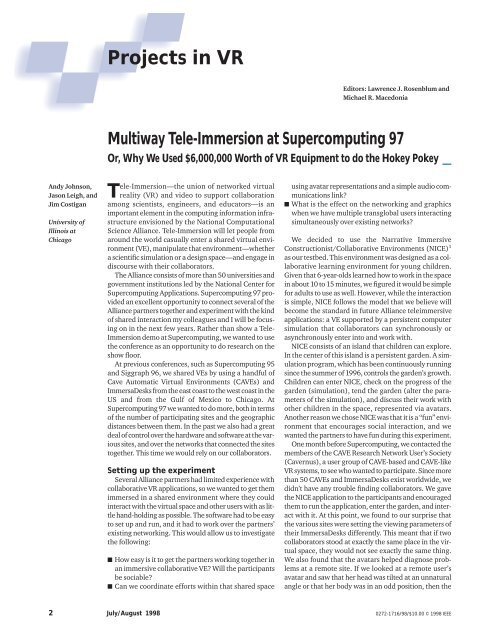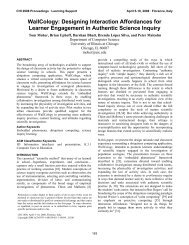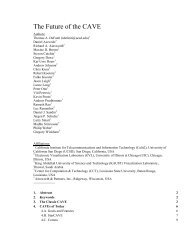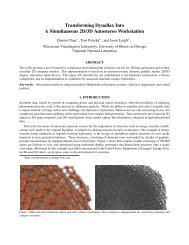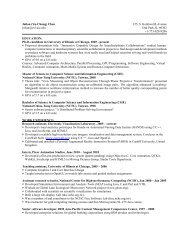Projects in VR - Electronic Visualization Laboratory - University of ...
Projects in VR - Electronic Visualization Laboratory - University of ...
Projects in VR - Electronic Visualization Laboratory - University of ...
Create successful ePaper yourself
Turn your PDF publications into a flip-book with our unique Google optimized e-Paper software.
Andy Johnson,<br />
Jason Leigh, and<br />
Jim Costigan<br />
<strong>University</strong> <strong>of</strong><br />
Ill<strong>in</strong>ois at<br />
Chicago<br />
2 July/August 1998<br />
<strong>Projects</strong> <strong>in</strong> <strong>VR</strong><br />
Tele-Immersion—the union <strong>of</strong> networked virtual<br />
reality (<strong>VR</strong>) and video to support collaboration<br />
among scientists, eng<strong>in</strong>eers, and educators—is an<br />
important element <strong>in</strong> the comput<strong>in</strong>g <strong>in</strong>formation <strong>in</strong>frastructure<br />
envisioned by the National Computational<br />
Science Alliance. Tele-Immersion will let people from<br />
around the world casually enter a shared virtual environment<br />
(VE), manipulate that environment—whether<br />
a scientific simulation or a design space—and engage <strong>in</strong><br />
discourse with their collaborators.<br />
The Alliance consists <strong>of</strong> more than 50 universities and<br />
government <strong>in</strong>stitutions led by the National Center for<br />
Supercomput<strong>in</strong>g Applications. Supercomput<strong>in</strong>g 97 provided<br />
an excellent opportunity to connect several <strong>of</strong> the<br />
Alliance partners together and experiment with the k<strong>in</strong>d<br />
<strong>of</strong> shared <strong>in</strong>teraction my colleagues and I will be focus<strong>in</strong>g<br />
on <strong>in</strong> the next few years. Rather than show a Tele-<br />
Immersion demo at Supercomput<strong>in</strong>g, we wanted to use<br />
the conference as an opportunity to do research on the<br />
show floor.<br />
At previous conferences, such as Supercomput<strong>in</strong>g 95<br />
and Siggraph 96, we shared VEs by us<strong>in</strong>g a handful <strong>of</strong><br />
Cave Automatic Virtual Environments (CAVEs) and<br />
ImmersaDesks from the east coast to the west coast <strong>in</strong> the<br />
US and from the Gulf <strong>of</strong> Mexico to Chicago. At<br />
Supercomput<strong>in</strong>g 97 we wanted to do more, both <strong>in</strong> terms<br />
<strong>of</strong> the number <strong>of</strong> participat<strong>in</strong>g sites and the geographic<br />
distances between them. In the past we also had a great<br />
deal <strong>of</strong> control over the hardware and s<strong>of</strong>tware at the various<br />
sites, and over the networks that connected the sites<br />
together. This time we would rely on our collaborators.<br />
Sett<strong>in</strong>g up the experiment<br />
Several Alliance partners had limited experience with<br />
collaborative <strong>VR</strong> applications, so we wanted to get them<br />
immersed <strong>in</strong> a shared environment where they could<br />
<strong>in</strong>teract with the virtual space and other users with as little<br />
hand-hold<strong>in</strong>g as possible. The s<strong>of</strong>tware had to be easy<br />
to set up and run, and it had to work over the partners’<br />
exist<strong>in</strong>g network<strong>in</strong>g. This would allow us to <strong>in</strong>vestigate<br />
the follow<strong>in</strong>g:<br />
■ How easy is it to get the partners work<strong>in</strong>g together <strong>in</strong><br />
an immersive collaborative VE? Will the participants<br />
be sociable?<br />
■ Can we coord<strong>in</strong>ate efforts with<strong>in</strong> that shared space<br />
Editors: Lawrence J. Rosenblum and<br />
Michael R. Macedonia<br />
Multiway Tele-Immersion at Supercomput<strong>in</strong>g 97<br />
Or, Why We Used $6,000,000 Worth <strong>of</strong> <strong>VR</strong> Equipment to do the Hokey Pokey __<br />
us<strong>in</strong>g avatar representations and a simple audio communications<br />
l<strong>in</strong>k?<br />
■ What is the effect on the network<strong>in</strong>g and graphics<br />
when we have multiple transglobal users <strong>in</strong>teract<strong>in</strong>g<br />
simultaneously over exist<strong>in</strong>g networks?<br />
We decided to use the Narrative Immersive<br />
Constructionist/Collaborative Environments (NICE) 1<br />
as our testbed. This environment was designed as a collaborative<br />
learn<strong>in</strong>g environment for young children.<br />
Given that 6-year-olds learned how to work <strong>in</strong> the space<br />
<strong>in</strong> about 10 to 15 m<strong>in</strong>utes, we figured it would be simple<br />
for adults to use as well. However, while the <strong>in</strong>teraction<br />
is simple, NICE follows the model that we believe will<br />
become the standard <strong>in</strong> future Alliance teleimmersive<br />
applications: a VE supported by a persistent computer<br />
simulation that collaborators can synchronously or<br />
asynchronously enter <strong>in</strong>to and work with.<br />
NICE consists <strong>of</strong> an island that children can explore.<br />
In the center <strong>of</strong> this island is a persistent garden. A simulation<br />
program, which has been cont<strong>in</strong>uously runn<strong>in</strong>g<br />
s<strong>in</strong>ce the summer <strong>of</strong> 1996, controls the garden’s growth.<br />
Children can enter NICE, check on the progress <strong>of</strong> the<br />
garden (simulation), tend the garden (alter the parameters<br />
<strong>of</strong> the simulation), and discuss their work with<br />
other children <strong>in</strong> the space, represented via avatars.<br />
Another reason we chose NICE was that it is a “fun” environment<br />
that encourages social <strong>in</strong>teraction, and we<br />
wanted the partners to have fun dur<strong>in</strong>g this experiment.<br />
One month before Supercomput<strong>in</strong>g, we contacted the<br />
members <strong>of</strong> the CAVE Research Network User’s Society<br />
(Cavernus), a user group <strong>of</strong> CAVE-based and CAVE-like<br />
<strong>VR</strong> systems, to see who wanted to participate. S<strong>in</strong>ce more<br />
than 50 CAVEs and ImmersaDesks exist worldwide, we<br />
didn’t have any trouble f<strong>in</strong>d<strong>in</strong>g collaborators. We gave<br />
the NICE application to the participants and encouraged<br />
them to run the application, enter the garden, and <strong>in</strong>teract<br />
with it. At this po<strong>in</strong>t, we found to our surprise that<br />
the various sites were sett<strong>in</strong>g the view<strong>in</strong>g parameters <strong>of</strong><br />
their ImmersaDesks differently. This meant that if two<br />
collaborators stood at exactly the same place <strong>in</strong> the virtual<br />
space, they would not see exactly the same th<strong>in</strong>g.<br />
We also found that the avatars helped diagnose problems<br />
at a remote site. If we looked at a remote user’s<br />
avatar and saw that her head was tilted at an unnatural<br />
angle or that her body was <strong>in</strong> an odd position, then the<br />
0272-1716/98/$10.00 © 1998 IEEE
emote site might have problems<br />
with track<strong>in</strong>g that were not visible<br />
locally. This prompted us to th<strong>in</strong>k<br />
about prescrib<strong>in</strong>g a set <strong>of</strong> protocols<br />
to guarantee proper CAVE/<br />
ImmersaDesk calibration.<br />
At Supercomput<strong>in</strong>g<br />
At the conference, we ran our experiment<br />
twice, for one hour each<br />
time. On the exhibit floor we used<br />
six ImmersaDesks and one<br />
ImmersaDesk2. Remote participants<br />
<strong>in</strong>cluded four CAVEs, five ImmersaDesks, several<br />
CAVE simulators runn<strong>in</strong>g on workstations, and one<br />
Web-based Java <strong>in</strong>terface. The collaborators ranged<br />
from the west coast to the east coast <strong>of</strong> the US and<br />
<strong>in</strong>cluded sites <strong>in</strong> the Netherlands and Japan. These collaborators<br />
also used a variety <strong>of</strong> Silicon Graphics hardware<br />
to run their <strong>VR</strong> systems. There were Maximum<br />
Impact-based CAVE simulators, ImmersaDesks run<br />
from Octanes, deskside Onyxs and Onyx 2s, and CAVEs<br />
run from rack Onyxs and Onyx 2s.<br />
The full list <strong>of</strong> collaborators <strong>in</strong>cluded<br />
■ Virtual Environments Lab at the Center for Coastal<br />
Physical Oceanography, Old Dom<strong>in</strong>ion <strong>University</strong><br />
Norfolk, Virg<strong>in</strong>ia (ImmersaDesk)<br />
■ <strong>Electronic</strong> <strong>Visualization</strong> <strong>Laboratory</strong>, <strong>University</strong> <strong>of</strong><br />
Ill<strong>in</strong>ois at Chicago, (two CAVEs, an ImmersaDesk, and<br />
a simulator)<br />
■ Virtual Reality/Virtual Environments Lab, Indiana<br />
<strong>University</strong>, Bloom<strong>in</strong>gton, Indiana (CAVE)<br />
■ SARA (Sticht<strong>in</strong>g Academisch Rekencentrum<br />
Amsterdam), Amsterdam, Netherlands (CAVE and<br />
simulator)<br />
■ Cray Research, Eagan, M<strong>in</strong>nesota (ImmersaDesk)<br />
■ The Scientific Comput<strong>in</strong>g and <strong>Visualization</strong> Group’s<br />
<strong>Laboratory</strong> for Immersive Virtual Environments,<br />
Boston <strong>University</strong>, Boston (ImmersaDesk)<br />
■ Towa <strong>University</strong>, Fukuoka, Japan (ImmersaDesk)<br />
Participants on the exhibit floor at Supercomput<strong>in</strong>g<br />
97 <strong>in</strong>cluded<br />
■ Army Research <strong>Laboratory</strong> (ImmersaDesk)<br />
■ <strong>Laboratory</strong> for Advanced Comput<strong>in</strong>g, <strong>University</strong> <strong>of</strong><br />
Ill<strong>in</strong>ois at Chicago (ImmersaDesk and Web-based<br />
Java client)<br />
■ Argonne National <strong>Laboratory</strong> (two ImmersaDesks)<br />
■ National Computational Science Alliance<br />
(ImmersaDesk2)<br />
■ Department <strong>of</strong> Computer Science, <strong>University</strong> <strong>of</strong><br />
Ill<strong>in</strong>ois at Urbana-Champaign (ImmersaDesk)<br />
■ Virtual Reality/Virtual Environments Lab, Indiana<br />
<strong>University</strong> (ImmersaDesk)<br />
All these collaborators were connected to the simulation<br />
that ma<strong>in</strong>ta<strong>in</strong>ed the state <strong>of</strong> the garden, and to a central<br />
user datagram protocol (UDP) reflector, both located at<br />
the Interactive Comput<strong>in</strong>g Environments <strong>Laboratory</strong> <strong>of</strong><br />
the <strong>University</strong> <strong>of</strong> Ill<strong>in</strong>ois at Chicago, as shown <strong>in</strong> Figure 1.<br />
2 The popular<br />
“Dennis<br />
Rodman”<br />
avatar. When<br />
we participate<br />
<strong>in</strong> transcont<strong>in</strong>ental<br />
or<br />
transglobal<br />
collaborations<br />
from our lab, it<br />
helps to have a<br />
recognizable<br />
Chicago personality<br />
as the<br />
avatar from<br />
Chicago.<br />
Dur<strong>in</strong>g our experiment, we had a few network<strong>in</strong>g<br />
problems, partly due to <strong>in</strong>termittent network<strong>in</strong>g at the<br />
conference itself and to runn<strong>in</strong>g both the server for the<br />
garden and UDP reflector on the same Indy (which also<br />
acted as an active Web server). We <strong>in</strong>tentionally placed<br />
the server on an active Web site, s<strong>in</strong>ce this made it easy<br />
to distribute updated models for the garden. We were<br />
also curious to see how well a s<strong>in</strong>gle server would perform<br />
under these conditions. From discussions with our<br />
partners, it seemed that there would typically be at most<br />
a handful <strong>of</strong> people collaborat<strong>in</strong>g <strong>in</strong> such a world,<br />
though there could be more for a distributed presentation<br />
with<strong>in</strong> the space. As the number <strong>of</strong> clients<br />
<strong>in</strong>creased, the server became overloaded, but it recovered<br />
well, and all the client s<strong>of</strong>tware recovered dynamically<br />
to keep the environment go<strong>in</strong>g. This k<strong>in</strong>d <strong>of</strong> fault<br />
tolerance meant that we didn’t have to cont<strong>in</strong>ually<br />
restart every client when the network went down.<br />
Another problem we encountered was with remote<br />
clients who tried to connect through their local firewalls.<br />
The other collaborators could see them, but they could<br />
not see anyone else.<br />
With<strong>in</strong> the space itself we were partly a victim <strong>of</strong> our<br />
own success. We had designed several avatars for the<br />
orig<strong>in</strong>al NICE application and added several more for<br />
this experiment, but not enough to give everyone a<br />
unique character (more than a few people wanted to be<br />
the Dennis Rodman avatar shown <strong>in</strong> Figure 2). The plan<br />
1 A map <strong>of</strong> all<br />
<strong>of</strong> the sites<br />
<strong>in</strong>volved <strong>in</strong> the<br />
experiment.<br />
IEEE Computer Graphics and Applications 3
<strong>Projects</strong> <strong>in</strong> <strong>VR</strong><br />
3 Photos taken<br />
by Tom C<strong>of</strong>f<strong>in</strong> at<br />
Supercomput<strong>in</strong>g<br />
dur<strong>in</strong>g the<br />
collaboration.<br />
4 Snapshots taken with<strong>in</strong> the<br />
virtual space dur<strong>in</strong>g the collaboration.<br />
Clockwise from top left: SARA<br />
<strong>in</strong> the Netherlands <strong>of</strong>fer<strong>in</strong>g a flower<br />
to one <strong>of</strong> the participants <strong>in</strong><br />
Chicago; the Army Research Lab<br />
claim<strong>in</strong>g the high ground; a small<br />
gather<strong>in</strong>g <strong>in</strong> the catacombs; and a<br />
crowd <strong>in</strong> the garden.<br />
4 July/August 1998<br />
was that each site would develop its own Virtual Reality<br />
Model<strong>in</strong>g Language (<strong>VR</strong>ML)-based avatar body parts,<br />
but there was not enough time to do this. While each<br />
participant could choose a name for their chosen avatar<br />
and have that name appear on their character’s chest, a<br />
certa<strong>in</strong> amount <strong>of</strong> confusion still existed. We encouraged<br />
names such as “Kukimoto_<strong>in</strong>_Japan” or<br />
“Jim_at_SC97” so that we could not only tell to whom<br />
we were talk<strong>in</strong>g to, but how far away they were.<br />
We set up a conference call so participants could talk<br />
to each other <strong>in</strong> real time. Audio amplitude was sent over<br />
the network along with other positional <strong>in</strong>formation to<br />
move each avatar’s mouth and body. The mouth movement<br />
allowed remote users to correlate a voice with an<br />
avatar. This technique has worked well <strong>in</strong> past small<br />
group collaborations—we wanted to see how it worked<br />
with 10 or more people. It worked better than expected<br />
when a s<strong>in</strong>gle person presented or lead and others<br />
responded or asked questions. Communication started<br />
to break down when multiple tasks or groups began to<br />
form, as the audio had no correlation to the virtual<br />
space. Remote users who were nearby <strong>in</strong> the virtual<br />
space had the same volume as those far away. We have<br />
not found an <strong>in</strong>expensive solution to this problem that<br />
still delivers the real-time audio necessary to susta<strong>in</strong> this<br />
level <strong>of</strong> <strong>in</strong>teraction.<br />
Differences between the various hardware platforms<br />
quickly became noticeable as the number <strong>of</strong> users<br />
<strong>in</strong>creased beyond 10. The slower SGI workstations (that<br />
is, anyth<strong>in</strong>g less than an Onyx) could not keep up with<br />
Images courtesy <strong>of</strong> Tom C<strong>of</strong>f<strong>in</strong>
the render<strong>in</strong>g. This was a larger h<strong>in</strong>drance to collaboration<br />
than network lag, though the guaranteed real-time<br />
audio l<strong>in</strong>k kept the situation from gett<strong>in</strong>g too chaotic.<br />
We were <strong>in</strong>terested <strong>in</strong> whether people would be sociable<br />
<strong>in</strong> the space and whether they could coord<strong>in</strong>ate their<br />
efforts and work together. Part <strong>of</strong> the demo was devoted<br />
to lett<strong>in</strong>g various subgroups form and explore parts<br />
<strong>of</strong> the island such as <strong>in</strong> a <strong>VR</strong> multiuser dungeon (MUD).<br />
Another part focused on “centralized” activity such as<br />
clear<strong>in</strong>g the garden <strong>of</strong> weeds.<br />
S<strong>in</strong>ce the audio l<strong>in</strong>k was a real-time l<strong>in</strong>k between all<br />
the sites, this allowed us to look at the lag <strong>in</strong> the transmission<br />
<strong>of</strong> avatar position data. To get a sense <strong>of</strong> this<br />
with<strong>in</strong> the environment, we gathered most <strong>of</strong> the collaborators<br />
together and did the Hokey Pokey. The Hokey<br />
Pokey is a rather silly American dance where the <strong>in</strong>structions<br />
and lyrics follow the general pattern <strong>of</strong> “You put<br />
your right hand <strong>in</strong>, you take your right hand out, you<br />
put your right hand <strong>in</strong> and you shake it all about, you do<br />
the Hokey Pokey and you turn yourself around, that’s<br />
what it’s all about.” S<strong>in</strong>ce our avatars had a head, a body,<br />
and one arm, we modified the dance slightly, but you<br />
could get a very good idea what each user was do<strong>in</strong>g (at<br />
least when the server wasn’t overloaded). With everyone<br />
listen<strong>in</strong>g and several people s<strong>in</strong>g<strong>in</strong>g the <strong>in</strong>structions<br />
with m<strong>in</strong>imal lag, it allowed us to see how much time it<br />
took for the avatars to go through the motions.<br />
Figures 3 and 4 show several photos taken dur<strong>in</strong>g the<br />
multiway demo, both live shots taken on the floor <strong>of</strong><br />
Supercomput<strong>in</strong>g 97 and shots taken by a virtual camera<br />
with<strong>in</strong> the virtual space.<br />
Future work<br />
We found that it was possible to quickly field a collaborative<br />
<strong>VR</strong> environment over exist<strong>in</strong>g networks,<br />
though we need to work on ensur<strong>in</strong>g that all our collaborators<br />
have properly calibrated equipment. We also<br />
observed that the participants were very sociable and<br />
they could coord<strong>in</strong>ate action with<strong>in</strong> the space. We found<br />
that build<strong>in</strong>g <strong>in</strong> automatic recovery <strong>in</strong>to the server and<br />
clients was very important, that the server should reside<br />
on a decent mach<strong>in</strong>e, and that guaranteed quality-<strong>of</strong>service<br />
is a necessity for the next generation <strong>of</strong> these<br />
k<strong>in</strong>d <strong>of</strong> VEs. And we discovered that our collaborators<br />
had a lot <strong>of</strong> fun participat<strong>in</strong>g <strong>in</strong> our experiment.<br />
We believe it’s important to build these collaborative<br />
worlds and let doma<strong>in</strong> scientists and educators play with<br />
them to see where we should focus our efforts. This<br />
experiment showed us that a lot <strong>of</strong> stuff works, but a lot<br />
can be improved. The venue for those improvements will<br />
be CavernS<strong>of</strong>t 2,3 —the hybrid real-time network<strong>in</strong>g and<br />
persistent datastore library we’re currently develop<strong>in</strong>g<br />
to better support data distribution <strong>in</strong> Tele-Immersion.<br />
CavernS<strong>of</strong>t uses Nexus from Argonne National Labs for<br />
its network<strong>in</strong>g support and PTool from the <strong>Laboratory</strong><br />
for Advanced Comput<strong>in</strong>g at the <strong>University</strong> <strong>of</strong> Ill<strong>in</strong>ois at<br />
Chicago for its database support. Also, collaborative<br />
spaces such as these br<strong>in</strong>g up many <strong>in</strong>terest<strong>in</strong>g communications<br />
issues, which we’re cont<strong>in</strong>u<strong>in</strong>g to <strong>in</strong>vestigate.<br />
So what’s <strong>in</strong> store for us at Supercomput<strong>in</strong>g 98? Our<br />
experiment allowed us to look at logistical issues, both<br />
outside and <strong>in</strong>side the virtual space. Supercomput<strong>in</strong>g<br />
Related Web Pages<br />
Here are some related Web pages <strong>of</strong> projects or tools mentioned<br />
<strong>in</strong> this article.<br />
Tele-Immersion at EVL: http://www.evl.uic.edu/spiff/ti/<br />
NICE: http://www.ice.eecs.uic.edu/~nice<br />
Cavernus: http://www.ncsa.uiuc.edu/<strong>VR</strong>/cavernus/<br />
Nexus: http://www.mcs.anl.gov/nexus/<br />
PTool: http://www.lac.uic.edu/<br />
98 may be a good place to look more <strong>in</strong> depth at the communication<br />
issues with<strong>in</strong> a couple <strong>of</strong> specific collaborative<br />
visualization and design spaces. Plus, we still have<br />
several more cont<strong>in</strong>ents to connect to. . . and then, <strong>of</strong><br />
course, there’s Mir. ■<br />
Acknowledgments<br />
We would like to thank the follow<strong>in</strong>g people for help<strong>in</strong>g<br />
to make our experiment possible at the various sites:<br />
Joe Alexander, Rick Angel<strong>in</strong>i, Stuart Bailey, Lilac<br />
Berniker, Edward Berrdveld, Hisham Bizri, Glenn<br />
Bresnahan, Erik Brisson, Max<strong>in</strong>e Brown, Russell<br />
Burgett, Tom C<strong>of</strong>f<strong>in</strong>, Junna Cui, Kathleen Curry, Marek<br />
Czernuszenko, Fred Dech, Tom DeFanti, Ralph De<br />
Stefano, Margaret Dol<strong>in</strong>sky, Ian Foster, Tom Frisch, Sara<br />
Graffunder, Karen Green, Bob Grossman, John Hicks,<br />
Tomoko Imai, Joe Insley, Wilfred Janssen, Ted Jordan,<br />
Hank Kaczmarski, Abh<strong>in</strong>av Kapoor, Kelly Kirk, Cal<br />
Kirchh<strong>of</strong>, Anton Kon<strong>in</strong>g, Dick LaRoche, Cathy Lascara,<br />
Johnny Lawson, Gary L<strong>in</strong>dahl, Nobuyuki Kukimoto,<br />
John Melchi, Bill Nickless, Dave Pape, Mike Papka,<br />
Kyoung Park, Dana Plepys, Robert Putnam, Larry<br />
Ramey, Dan Reed, Paul Rossman, Nancy Rowe, Bill<br />
Sherman, Shuji Suma, Larry Smarr, Craig Stewart, Rick<br />
Stevens, Matt Szymanski, Samroeng Thongrong, Jeroen<br />
van Ho<strong>of</strong>, Rene van der Moolen, Luc Verburgh, Alan<br />
Verlo, Fang Wang, Eric Wernert, and Glenn Wheless.<br />
References<br />
1. A. Johnson et al., “The NICE Project: Learn<strong>in</strong>g Together <strong>in</strong><br />
a Virtual World,” Proc. <strong>VR</strong>AIS 98, IEEE Computer Society<br />
Press, Los Alamitos, Calif., 1998, pp. 176-183.<br />
2. J. Leigh, A. Johnson, and T. DeFanti, “Cavern: A Distributed<br />
Architecture for Support<strong>in</strong>g Scalable Persistence and<br />
Interoperability <strong>in</strong> Collaborative Virtual Environments,”<br />
Virtual Reality: Research, Development, and Applications,<br />
Vol. 2, No. 2, Dec. 1997, pp. 217-237.<br />
3. J. Leigh, A. Johnson, and T. DeFanti, “Issues <strong>in</strong> the Design<br />
<strong>of</strong> a Flexible Distributed Architecture for Support<strong>in</strong>g Persistence<br />
and Interoperability <strong>in</strong> Collaborative Virtual Environments,”<br />
Proc. Supercomput<strong>in</strong>g 97, 1997,<br />
http://www.supercomp.org/sc97/proceed<strong>in</strong>gs.<br />
Contact Johnson at the <strong>Electronic</strong> <strong>Visualization</strong> Lab,<br />
<strong>University</strong> <strong>of</strong> Ill<strong>in</strong>ois at Chicago, 851 S. Morgan St., Room<br />
1120 SEO, Chicago, IL 60607-7053, e-mail ajohnson@<br />
eecs.uic.edu.<br />
IEEE Computer Graphics and Applications 5


